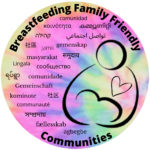Breastfeeding Saves Lives! It is critical for the optimal health and development of infants. Breastfeeding reduces an infant’s risk of childhood illness, such as obesity, diabetes, ear infections, diarrhea, and pneumonia. Breastfeeding also is associated with a reduced risk of maternal breast and ovarian cancers and a faster recovery from childbirth as compared to formula feeding.
The WHO1 and UNICEF2 recommend that infants are breastfed within the first hour after birth and exclusively breastfed for the first six months of life, that is, the infant receives no other foods or liquids for six months. At six months, infants begin receiving complementary foods while continuing to breastfeed for up to 2 years and longer.
Both organizations continue to recommend exclusive and continued breastfeeding during these stressful times when communities are facing healthcare and economic challenges due to COVID-19, citing the importance that breastfeeding plays in optimal growth and development of infants. UNICEF3 provides answers to many questions that parents may be asking; WHO4 offers infographics that provide guidance for families and health care providers.

Why are Breastfeeding Family Friendly Communities important?
Most families initiate breastfeeding right after the birth of their infant; however, many families stop breastfeeding, especially exclusive breastfeeding, in the early weeks and months of their baby’s life. As reported by the WHO5, “nearly 2 out of 3 infants are not exclusively breastfed for the recommended 6 months—a rate that has not improved in 2 decades.”
In the article Here’s how to make our cities breastfeeding-friendly6, Donovan, Rudner, and Amir state “If, as a society, we want to make sure the benefits of breastfeeding are spread as widely as possible, we need to look at what is bringing breastfeeding to a premature conclusion and what we can do about it.”
Designing community spaces is an important component of the breastfeeding friendly community, and a discussion about ways to be breastfeeding friendly remains crucial in the current health crisis. Breastfeeding parents, especially essential workers who do not have the option to work from home, continue to be present in their communities and need community support. The authors offer guidelines on the design of breastfeeding friendly communities, based on data from their study, Understanding community attitudes and identifying design solutions to increase women’s comforts with breastfeeding in public7, in which the authors received feedback from parents, health professionals, and government planning staff.
Breastfeeding family friendly communities recognize that families are able to meet their breastfeeding/chestfeeding goals when they are supported – by close family members, extended family, friends, acquaintances, healthcare providers, childcare providers, schools, businesses, and, really, everyone in their community. A breastfeeding family friendly community welcomes breastfeeding/chestfeeding families in all the places that families work or need to access in their community – grocery stores and markets, restaurants, stores and shopping malls, pools and beaches, movie theaters, parks, museums, doctors’ and dentists’ offices, hospitals, places of worship, and more. Breastfeeding/chestfeeding spaces in these locations are more than well-designed lactation rooms. Lactation rooms are helpful for parents who prefer privacy; however, these rooms also isolate families, keeping parents out of sight from others who might benefit from the opportunity to see infants nursed while parents are engaged in their community.
Breastfeeding Family Friendly Communities (BFFC) is committed to building communities that welcome all breastfeeding families. The BFFC vision is a world in which communities make a commitment to equity in their policies and practices to protect and promote the rights of all breastfeeding, chestfeeding, and human milk feeding families, and all families are supported by their community to meet their breastfeeding, chestfeeding, and human milk feeding goals.
Another space that BFFC recognizes as vital to becoming breastfeeding family friendly is the space surrounding equity in breastfeeding8. In the midst of the COVID-19 crisis in the US, we have been confronted by the lack of equity in our communities9,10. Government, health care, child care, school, faith-based, nonprofit, and business communities all have a role in ensuring equity11 in policies and practices that protect and promote the rights of all breastfeeding, chestfeeding, and human milk feeding families. Inequities in any of these parts create barriers for families to successfully meet their breastfeeding/chestfeeding goals.
Donovan, Rudner, and Amir Donovan provide a valuable perspective about the breadth of the work needed to become a breastfeeding family friendly community, reminding us that “creating a sense that our towns and cities are breastfeeding-friendly requires cultivating change in people’s hearts and minds as much as it is about making changes on the ground.” This is a good time for communities to act on their commitment to a breastfeeding friendly community. Families will benefit when communities design physical spaces that welcome breastfeeding/chestfeeding, ensure equity in breastfeeding/chestfeeding policies and practices, and work to foster a change in the community’s heart to create a Breastfeeding Family Friendly Community.
1World Health Organization (WHO). Breastfeeding: Recommendations. 2020.
2UNICEF. Infant and Young Child Feeding, October 2019.
4World Health Organization (WHO). Pregnancy, Childbirth, breastfeeding and COVID-19. 2020.
5World Health Organization (WHO). Breastfeeding: Overview. 2020.
9NAACP. Ten Equity Implications of the Coronavirus COVID-19 Outbreak in the United States. 2020.
10Dutchen S. Equity in the Time of Coronavirus. Harvard Medical School News and Research, 5 May 2020.
